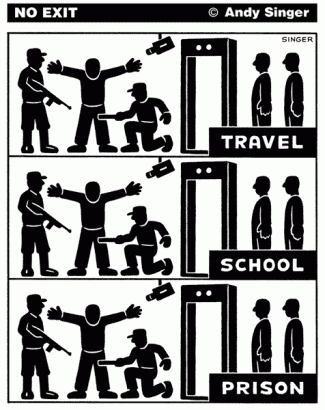Prison Nation
See also Michael Myser, Inside the $37 billion prison economy, Business 2.0./ CNN Money (6 Dec): “The nation’s 2 million inmates and their keepers are the ultimate captive market: a multibillion dollar economy bulging with business opportunity.”
1 in every 32 U.S. adults behind bars, on probation or on parole in 2005
The Associated Press |  1 December 2006 AP
1 December 2006 AP
A record 7 million people — or one in every 32 American adults — were behind bars, on probation or on parole by the end of last year, according to the Justice Department.
Of those, 2.2 million were in prison or jail, an increase of 2.7 percent over the previous year, according to a report released Wednesday.
More than 4.1 million people were on probation and 784,208 were on parole at the end of 2005. Prison releases are increasing, but admissions are increasing more.
Men still far outnumber women in prisons and jails, but the female population is growing faster. Over the past year, the female population in state or federal prison increased 2.6 percent while the number of male inmates rose 1.9 percent. By year’s end, 7 percent of all inmates were women. The gender figures do not include inmates in local jails.
“Today’s figures fail to capture incarceration’s impact on the thousands of children left behind by mothers in prison,” Marc Mauer, the executive director of the Sentencing Project, a Washington-based group supporting criminal justice reform, said in a statement. “Misguided policies that create harsher sentences for nonviolent drug offenses are disproportionately responsible for the increasing rates of women in prisons and jails.”
From 1995 to 2003, inmates in federal prison for drug offenses have accounted for 49 percent of total prison population growth.
The numbers are from the annual report from the Justice Department’s Bureau of Justice Statistics. The report breaks down inmate populations for state and federal prisons and local jails.
Racial disparities among prisoners persist. In the 25-29 age group, 8.1 percent of black men — about one in 13 — are incarcerated, compared with 2.6 percent of Hispanic men and 1.1 percent of white men. And it’s not much different among women. By the end of 2005, black women were more than twice as likely as Hispanics and over three times as likely as white women to be in prison.
Certain states saw more significant changes in prison population. In South Dakota, the number of inmates increased 11 percent over the past year, more than any other state. Montana and Kentucky were next in line with increases of 10.4 percent and 7.9 percent, respectively. Georgia had the biggest decrease, losing 4.6 percent, followed by Maryland with a 2.4 percent decrease and Louisiana with a 2.3 percent drop.

Recent Comments